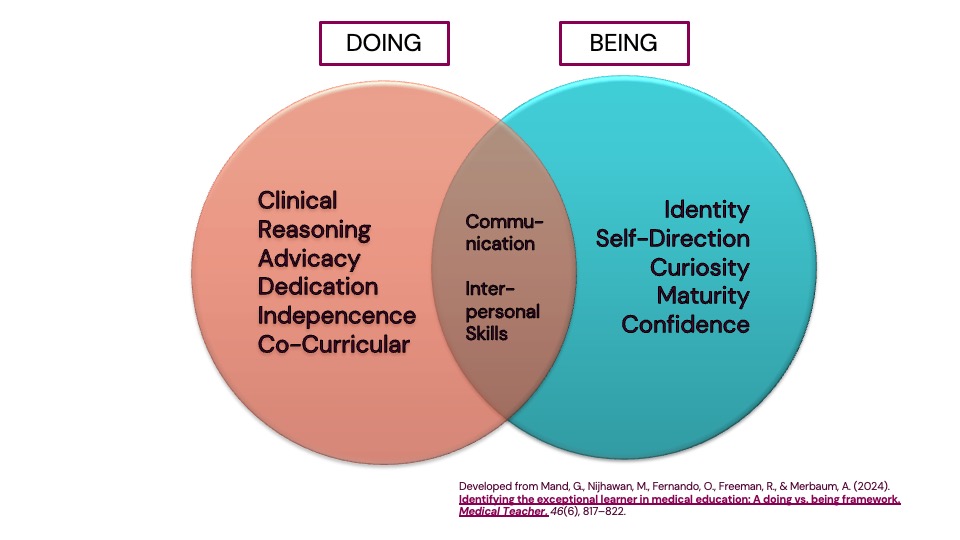#64 – Learners Got Talent?
Episode host: Jason Frank.

Can innate talent be distinguished from hard-earned skills? Over recent decades, much has been written about the learner in difficulty, but what about the exceptional learner? Jason introduces a paper that spotlights the “talented” trainee
Tune in for insights into competencies, developmental arcs, and the nuances of educational excellence.
Episode article
Mand, G., Nijhawan, M., Fernando, O., Freeman, R., & Merbaum, A. (2024). Identifying the exceptional learner in medical education: A doing vs. being framework. Medical Teacher, 46(6), 817–822.
Episode notes
Background
Health professions education researchers have developed an extensive body of literature about “learners in difficulty”. There are textbooks, policies, and guidelines on remediation of this subgroup who apparently comprise 3.5% of our community. There is almost nothing published on the other end of the curve—learners considered to be exceptional. Could teachers and educators even agree on what makes a learner stand out positively?
Psychologists make a distinction between “genius” (individuals who seem to be born with exceptional abilities) and “talent” (individuals who have worked hard to acquire exceptional abilities). We also know that more than IQ and marks are needed, from studies of students in university. If we focus on the “talented” learner in the health professions, what are their characteristics? Have we all seen them? Would we all agree who is in this category? Does using this label even make sense?
Purpose
Recognizing this gap in the literature, Gupreet Mand and colleagues from the University of Toronto embarked on a study to identify the characteristics of exceptional medical learners, as perceived by a group of Family Medicine physician supervisors.
Why should we care? Research suggests that 3-5% of learners are identified as exceptional. The authors argue that identifying these individuals is crucial for several reasons:
- Recruitment of future medical leaders (the “Best and Brightest” argument)
- Tailoring curricula to better serve these learners within Competency-Based Medical Education (CBME) (the “No Learner Left Behind” argument)
- Preventing talent neglect, which could lead to underperformance (the “Shrivel on the Vine” argument)
- Preparing these learners for future contributions to the medical field (the “Higher Curve” argument)
Methods
The researchers conducted a qualitative interview study with a diverse group of university-affiliated, community-based teachers who had been identified for their experiences supervising medical learners. The study includes a reflexivity statement to address researcher bias.
Results/Findings
A total of 15 interviews were conducted until data saturation was reached. The authors drew on established frameworks, including George Miller’s and Cruess et al’s “competence pyramids,” which highlight the progression from knowledge to demonstration to “being.”
The study introduces a new “Doing vs. Being” framework to describe the characteristics of exceptional learners:
- Doing: Acquired, concrete actions.
- Being: Innate, attitudes and approaches.
These attributes were found to align with existing frameworks, such as CanMEDS, and reflect the upper tiers of the Miller and Cruess pyramids.

These features were consistent with previous work. The authors acknowledged these largely reflected the CanMEDS framework. They also felt these characteristics reflected the top of the Miller or Cruess pyramids.
Conclusions
The authors concluded that their “Doing and Being” framework may help identify exceptional learners early, so that curriculum can be tailored to their unique needs.
PaperClips
- Some in the Health Professions Education (HPE) community may prefer to frame this discussion as one about developmental trajectories or the nature of competence rather than labeling learners as “exceptional” or “talented.”
- While frameworks like competence pyramids are useful for conceptual understanding, it’s important to remember that they are not evidence in themselves. Caution is advised against over-reliance on these illustrations as definitive models.
Resource
The Dreyfuss and Dreyfuss model (from 1980) Jon is referring to in the episode is explained and summarized by one of the original authors in this publication: Dreyfus, S. E. (2004). The Five-Stage Model of Adult Skill Acquisition. Bulletin of Science, Technology & Society, 24(3), 177–181.

0 comments